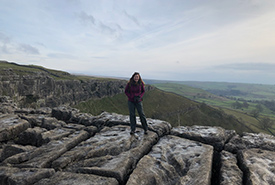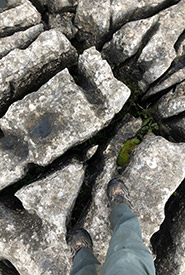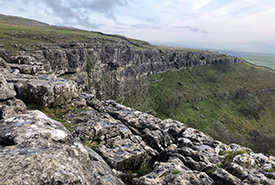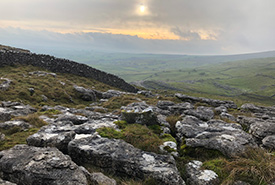Alvar explorations of a wandering biologist (part two)

Esme on the alvar in Malham Cove, U.K. (Photo by Esme Batten/NCC staff)
In part one, I explained what alvars are, where they occur and their importance. Now, I talk about my alvar explorations in the U.K.
On Boxing Day in 2018, I set off early in the morning from Cornwall, in the southwest end of the U.K., to drive seven hours north to Yorkshire. Located in Yorkshire Dales National Park, Malham Cove is a limestone pavement that was formed by meltwater after the last Ice Age. Limestone is very porous and susceptible to weathering, and limestone pavements often have deep cracks or fissures in the rocks, called “grykes,” or characteristic limestone blocks, called “clints.” However, perhaps the most striking feature at Malham Cove are the 80-metre-high cliffs that stretch approximately 300 metres long. These cliffs make this area a popular destination for tourists and locals alike. However, while most were exploring the cliffs, I spent my time on the limestone pavements to the north, around Malham Tarn.

Limestone pavements often have deep cracks or fissures in the rocks, called “grykes,” or characteristic limestone blocks, called “clints.”(Photo by Esme Batten/NCC staff)
I arrived at Malham just after 10 o’clock in the morning without a clear idea of where I was going. I just knew that I was in search of the limestone plains. From photos, I had discovered that they were most likely at the top of the cliff.
Those who know me are aware that at work, I am extremely organized, often planning my entire summer by the end of March. However, while travelling around the U.K. over the past few months, I tend to make last-minute plans without a clear idea of where I am actually going, much to my family’s dismay. I wouldn’t usually recommend this method, but with my navigation skills, compass, maps, etc., I am well prepared. However, following one group of people on this trip might not have been my greatest plan in terms of reaching the limestone plains quickly, but it certainly added to my trip.

Perhaps the most striking feature at Malham Cove are the 80-metre-high cliffs that stretch approximately 300 metres long. (Photo by Esme Batten/NCC staff)
As I found myself wandering away from the main group of people up the side of the cliff, I mustered up the courage to ask the family I had been quietly following where exactly they were headed. During my time in the U.K. so far, I’ve found that many people here are extremely friendly, and I quickly ended up joining the family for their hike. Luckily for me, they lived only 10 minutes down the road and provided some great information about the area. There had actually been quite a lot of mining in the area in the past, with old mine shafts across the landscape. Although there are no longer any active mines in the area now, there are roaming sheep and cattle everywhere.
Once we made it to the top of the cliff, I started to see some familiar habitat and quickly found myself lying on the pavement, looking at many familiar plant species in the grykes. Excited that I could identify even a few plants, I said good-bye to the lovely family I had been hiking with and started my explorations.
Although most of the habitat at Malham is relatively barren without much plant diversity on the open pavement itself, the more humid and slightly warmer microclimate created in the grykes supports a different range of vegetation, including various fern species, wood sorrel, dog’s mercury, various sedges and anemones. Much like in Ontario’s alvars, a rich diversity of lichens and moss can also be found at Malham, and I found myself moving slowly across the landscape. Although I couldn’t identify many of the plants I came across, especially due to the time of year, the openness of the community itself seems to be maintained by wind erosion and livestock grazing. During my explorations, I often found myself skirting around curious herds of sheep.

Alvar in Malham Cove, U.K. (Photo by Esme Batten/NCC staff)
After a few hours of exploring, the light was quickly fading, and I found myself slowly wandering back to the parking area, this time along the main path. I certainly didn’t even scratch the surface of what I am sure I could learn about Malham Cove, and more generally, limestone pavements in the U.K. with my quick five-hour visit, but I am excited to return, especially when the wildflowers are in bloom. Travelling around the U.K., whether it’s birding (twitching, to the Brits), botanizing or generally enjoying nature here, has certainly given me an appreciation for the fact that the conservation challenges we face back in Canada and on the Saugeen Bruce Peninsula where I work are similar wherever you go. We can continually learn from the work of our colleagues, and even work going on around the world. We should make sure that we are always curious and questioning why we are doing the work and how we can improve.
Before I return to Canada, I am excited to report that I will be visiting another limestone plain, but this time in Ireland. I am sure I will leave with more questions than answers, but I am looking forward to seeing what else I can learn about these amazing ecosystems.


